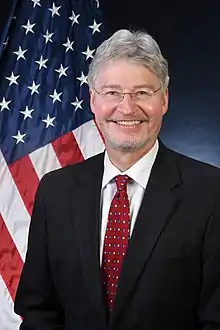Walter Copan
Walter Copan is an American chemist and government official who served as the Under Secretary of Commerce for Standards and Technology from 2017 to 2021. Prior to assuming his current role, he served as president and CEO of IP Engineering Group Corporation and as a board member of Rocky Mountain Innovation Partners.
Walter Copan | |
|---|---|
 | |
| Under Secretary of Commerce for Standards and Technology | |
| In office October 16, 2017 – January 20, 2021 | |
| President | Donald Trump |
| Preceded by | Willie E. May |
| Succeeded by | TBD |
| 16th Director of the National Institute of Standards and Technology | |
| In office October 16, 2017 – January 20, 2021 | |
| President | Donald Trump |
| Preceded by | Willie E. May |
| Succeeded by | TBD |
| Personal details | |
| Born | Walter George Copan |
| Education | Case Western Reserve University |
| Scientific career | |
| Fields | Physical chemistry |
| Institutions | |
| Thesis | Carbon-13 and Nitrogen-15 nuclear magnetic resonance studies of rhodopsin and bacteriorhodopsin (NMR) (1982) |
Early life and education
Copan received his B.A. in chemistry from Western Reserve College in 1975 and later his Ph.D. in physical chemistry from Case Western Reserve University in 1982.[1]
Career
Copan previously served as managing director of technology commercialization and partnerships at Brookhaven National Laboratory and as technology transfer at the National Renewable Energy Laboratory. During his time at Brookhaven, he led a pilot program across the United States Department of Energy called Agreements for Commercializing Technology. The program was praised for making intellectual property agreements between businesses and government more flexible and for promoting an entrepreneurial culture.[2] He led Clean Diesel Technologies onto NASDAQ while serving as CTO and executive vice president. Copan also had a 28-year career with Lubrizol, where he was active in research, development, and business unit management.[3][4] At Lubrizol, Copan led the company's European research and development during the late 1980s and early 1990s, including working with countries that had recently broken away from the Soviet Union.[5]
Under Secretary of Commerce for Standards and Technology
In September 2017, Copan was nominated by President Donald Trump to become Under Secretary of Commerce for Standards and Technology.[6] Copan's nomination was supported by the University Corporation for Atmospheric Research.[7] He was confirmed unanimously by the United States Senate in October 2017. Copan said his top priority in the role will be to implement the Cybersecurity Framework, a National Institute of Standards and Technology effort to improve network security across federal agencies and industry.[2] He left office on January 20, 2021.[8]
References
- Copan, Walter George (1982). Carbon-13 and Nitrogen-15 nuclear magnetic resonance studies of rhodopsin and bacteriorhodopsin (NMR) (Ph.D.). Case Western Reserve University. OCLC 8724955 – via ProQuest.
- Service, Robert (September 18, 2017). "Cybersecurity and technology transfer seen as top priorities for NIST director nominee". Science Magazine. Retrieved October 9, 2017.
- "President Donald J. Trump Announces Intent to Nominate Personnel to Key Administration Posts". The White House. September 12, 2017. Retrieved October 9, 2017.
- Martin, Nichols (September 14, 2017). "Walter Copan Nominated NIST Director, Commerce Undersecretary for Standards & Tech". ExecutiveGov. Retrieved October 9, 2017.
- Widener, Andrea (September 14, 2017). "Chemist nominated to lead the U.S. National Institute of Standards & Technology". Chemical & Engineering News. Retrieved October 9, 2017.
- Berliner, Ben (September 13, 2017). "Walter Copan tapped to lead NIST". FCW. Retrieved October 9, 2017.
- "UCAR statement on nomination of Walter Copan to head NIST". University Corporation for Atmospheric Research. September 15, 2017. Retrieved October 9, 2017.
- https://www.nist.gov/blogs/taking-measure/authors/walter-copan
| Government offices | ||
|---|---|---|
| Preceded by Willie E. May |
Director of the National Institute of Standards and Technology 2017 – present |
Incumbent |